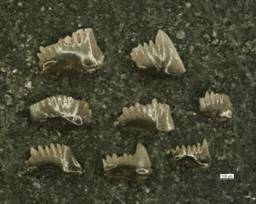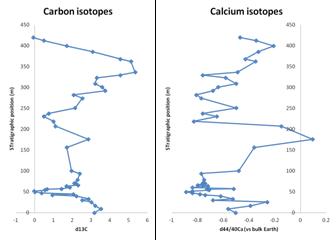www.acsprf.org
Reports: ND849237-ND8: A Paleotemperature Proxy Record Across the End-Permian Extinction Horizon and Through the Triassic Recovery Interval from Oxygen Isotopes in Conodont Apatite
Adina Paytan, PhD , University of California (Santa Cruz)
The Permian–Triassic (P–Tr) extinction event (251.4 Ma) was the Earth's most severe extinction event, with up to 96% of all marine species and 70% of terrestrial vertebrate species becoming extinct. The recovery of life on Earth following the P-Tr perturbation took significantly longer to recover than after other extinction events. There are several proposed mechanisms for the extinctions including large bolide impacts, increased volcanism, rlease of methane clathrate, anoxia and more. Regardless of the trigger mechanism geological evidence suggest profound changes in the carbon cycle across the boundary making this time period interesting as an analogue for future man induced perturbations in the carbon cycle including temperature and sea level raise and ocean acidification. It is therefore vital to be able to reconstruct the environmental conditions across this boundary.
This project seeks to reconstruct seawater temperature during this important time interval using the oxygen isotope record of conodont apatite from expanded stratigraphic section in southern China. The first year of the project was devoted to refining and testing a micro-precipitation procedure to extract, purify and precipitate apatite phosphate as silver phosphate; optimized and standardized the mass spectrometer for conducting analyses on small samples. We also collected more samples from sections in China to supplement sample coverage near the Permian-Triassic boundary and other intervals of interest identified. Over 300 rock samples were collected and their stratigraphic sequence recorded. In this second year of the project we have focused on extraction, separation and cleaning of the conodonts from these samples and describing the inventory including species abundance, sizes and preservation conditions. Some section had very low yield and specimens could not be used for multiple analyses (e.g. oxygen, strontium and calcium isotopes). A procedure has been developed to allow us to he full set of isotopes in a small sample. Some preliminary oxygen isotope data were obtained as well as some Ca and Sr data. Over the next year of the project more samples will be analyzed, data interpreted and a model for the coranon cycle perturbations across the boundary developed. The results of this study will help to constrain PTB carbon cycle models, GCMs, and extinction and recovery scenarios.
As a paloeoceanographer working on samples representing deep geological time if new for me and my students. The project exposed and challenges us to work with material from shallow marine sequences that have been subjected to meteoric conditions and diagenetic alteration. In addition there are many analytical challenges that we had to overcome. The work provided exciting opportunities for me and my students to work with collaborators in China, at Stanford and in Canada and to co-mentor students that focus on paleontology and field geologists rather then geochemistry.
Figure 1. Coupled carbon and calcium isotope perturbations across the P-Tr.
Figure 2. Conodonts from the Lower Guandao section, variety of element types from the latest Permian


